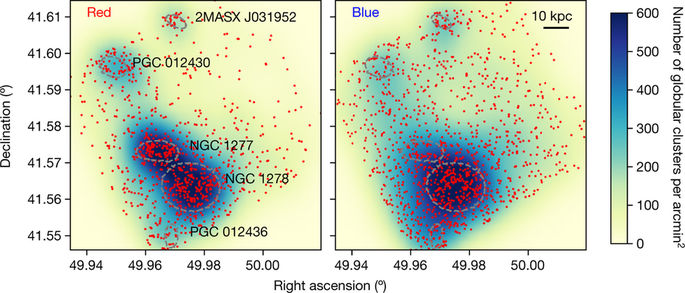Our official English website, www.x-mol.net, welcomes your feedback! (Note: you will need to create a separate account there.)
A single population of red globular clusters around the massive compact galaxy NGC 1277
Nature ( IF 64.8 ) Pub Date : 2018-03-01 , DOI: 10.1038/nature25756 Michael A. Beasley , Ignacio Trujillo , Ryan Leaman , Mireia Montes
Nature ( IF 64.8 ) Pub Date : 2018-03-01 , DOI: 10.1038/nature25756 Michael A. Beasley , Ignacio Trujillo , Ryan Leaman , Mireia Montes

|
Massive galaxies are thought to form in two phases: an initial collapse of gas and giant burst of central star formation, followed by the later accretion of material that builds up their stellar and dark-matter haloes. The systems of globular clusters within such galaxies are believed to form in a similar manner. The initial central burst forms metal-rich (spectrally red) clusters, whereas more metal-poor (spectrally blue) clusters are brought in by the later accretion of less-massive satellites. This formation process is thought to result in the multimodal optical colour distributions that are seen in the globular cluster systems of massive galaxies. Here we report optical observations of the massive relic-galaxy candidate NGC 1277—a nearby, un-evolved example of a high-redshift ‘red nugget’ galaxy. We find that the optical colour distribution of the cluster system of NGC 1277 is unimodal and entirely red. This finding is in strong contrast to other galaxies of similar and larger stellar mass, the cluster systems of which always exhibit (and are generally dominated by) blue clusters. We argue that the colour distribution of the cluster system of NGC 1277 indicates that the galaxy has undergone little (if any) mass accretion after its initial collapse, and use simulations of possible merger histories to show that the stellar mass due to accretion is probably at most ten per cent of the total stellar mass of the galaxy. These results confirm that NGC 1277 is a genuine relic galaxy and demonstrate that blue clusters constitute an accreted population in present-day massive galaxies.
中文翻译:

大质量致密星系NGC 1277周围的单个红色球状星团群
巨大的星系被认为分两个阶段形成:气体的初始坍缩和中央恒星形成的巨大爆发,随后是物质的吸积,从而形成了它们的恒星和暗物质晕。这些星系内的球状星团系统被认为是以类似的方式形成的。最初的中央爆发形成了富含金属(光谱为红色)的星团,而更多的缺乏金属(光谱为蓝色)的星团则是由后来质量较小的卫星的吸积带来的。这种形成过程被认为导致了在大质量星系的球状星团系统中看到的多模态光学颜色分布。在这里,我们报告了对大型遗迹星系候选者 NGC 1277 的光学观测——一个附近的、未进化的高红移“红色金块”星系的例子。我们发现 NGC 1277 星团系统的光学颜色分布是单峰的,完全是红色的。这一发现与其他具有类似和更大恒星质量的星系形成了强烈对比,它们的星团系统总是表现出(并且通常以)蓝色星团。我们认为 NGC 1277 星团系统的颜色分布表明该星系在其初始坍缩后几乎没有(如果有的话)质量吸积,并使用对可能合并历史的模拟来表明吸积引起的恒星质量可能为占银河系总恒星质量的百分之十。这些结果证实了 NGC 1277 是一个真正的遗迹星系,并表明蓝色星团构成了当今大质量星系中的吸积种群。这一发现与其他具有类似和更大恒星质量的星系形成了强烈对比,它们的星团系统总是表现出(并且通常以)蓝色星团。我们认为 NGC 1277 星团系统的颜色分布表明该星系在初始坍缩后几乎没有(如果有的话)质量吸积,并使用对可能合并历史的模拟来表明吸积引起的恒星质量可能为占银河系总恒星质量的百分之十。这些结果证实了 NGC 1277 是一个真正的遗迹星系,并表明蓝色星团构成了当今大质量星系中的吸积种群。这一发现与其他具有类似和更大恒星质量的星系形成强烈对比,这些星系的星团系统总是表现出(并且通常以)蓝色星团。我们认为 NGC 1277 星团系统的颜色分布表明该星系在初始坍缩后几乎没有(如果有的话)质量吸积,并使用对可能合并历史的模拟来表明吸积引起的恒星质量可能为占银河系总恒星质量的百分之十。这些结果证实了 NGC 1277 是一个真正的遗迹星系,并表明蓝色星团构成了当今大质量星系中的吸积种群。其星团系统总是展示(并且通常由)蓝色星团。我们认为 NGC 1277 星团系统的颜色分布表明该星系在初始坍缩后几乎没有(如果有的话)质量吸积,并使用对可能合并历史的模拟来表明吸积引起的恒星质量可能为占银河系总恒星质量的百分之十。这些结果证实了 NGC 1277 是一个真正的遗迹星系,并表明蓝色星团构成了当今大质量星系中的吸积种群。其星团系统总是展示(并且通常由)蓝色星团。我们认为 NGC 1277 星团系统的颜色分布表明该星系在初始坍缩后几乎没有(如果有的话)质量吸积,并使用对可能合并历史的模拟来表明吸积引起的恒星质量可能为占银河系总恒星质量的百分之十。这些结果证实了 NGC 1277 是一个真正的遗迹星系,并表明蓝色星团构成了当今大质量星系中的吸积种群。并使用对可能合并历史的模拟来表明吸积引起的恒星质量最多可能是星系总恒星质量的 10%。这些结果证实了 NGC 1277 是一个真正的遗迹星系,并表明蓝色星团构成了当今大质量星系中的吸积种群。并使用对可能合并历史的模拟来表明吸积引起的恒星质量最多可能是星系总恒星质量的 10%。这些结果证实了 NGC 1277 是一个真正的遗迹星系,并表明蓝色星团构成了当今大质量星系中的吸积种群。
更新日期:2018-03-01
中文翻译:

大质量致密星系NGC 1277周围的单个红色球状星团群
巨大的星系被认为分两个阶段形成:气体的初始坍缩和中央恒星形成的巨大爆发,随后是物质的吸积,从而形成了它们的恒星和暗物质晕。这些星系内的球状星团系统被认为是以类似的方式形成的。最初的中央爆发形成了富含金属(光谱为红色)的星团,而更多的缺乏金属(光谱为蓝色)的星团则是由后来质量较小的卫星的吸积带来的。这种形成过程被认为导致了在大质量星系的球状星团系统中看到的多模态光学颜色分布。在这里,我们报告了对大型遗迹星系候选者 NGC 1277 的光学观测——一个附近的、未进化的高红移“红色金块”星系的例子。我们发现 NGC 1277 星团系统的光学颜色分布是单峰的,完全是红色的。这一发现与其他具有类似和更大恒星质量的星系形成了强烈对比,它们的星团系统总是表现出(并且通常以)蓝色星团。我们认为 NGC 1277 星团系统的颜色分布表明该星系在其初始坍缩后几乎没有(如果有的话)质量吸积,并使用对可能合并历史的模拟来表明吸积引起的恒星质量可能为占银河系总恒星质量的百分之十。这些结果证实了 NGC 1277 是一个真正的遗迹星系,并表明蓝色星团构成了当今大质量星系中的吸积种群。这一发现与其他具有类似和更大恒星质量的星系形成了强烈对比,它们的星团系统总是表现出(并且通常以)蓝色星团。我们认为 NGC 1277 星团系统的颜色分布表明该星系在初始坍缩后几乎没有(如果有的话)质量吸积,并使用对可能合并历史的模拟来表明吸积引起的恒星质量可能为占银河系总恒星质量的百分之十。这些结果证实了 NGC 1277 是一个真正的遗迹星系,并表明蓝色星团构成了当今大质量星系中的吸积种群。这一发现与其他具有类似和更大恒星质量的星系形成强烈对比,这些星系的星团系统总是表现出(并且通常以)蓝色星团。我们认为 NGC 1277 星团系统的颜色分布表明该星系在初始坍缩后几乎没有(如果有的话)质量吸积,并使用对可能合并历史的模拟来表明吸积引起的恒星质量可能为占银河系总恒星质量的百分之十。这些结果证实了 NGC 1277 是一个真正的遗迹星系,并表明蓝色星团构成了当今大质量星系中的吸积种群。其星团系统总是展示(并且通常由)蓝色星团。我们认为 NGC 1277 星团系统的颜色分布表明该星系在初始坍缩后几乎没有(如果有的话)质量吸积,并使用对可能合并历史的模拟来表明吸积引起的恒星质量可能为占银河系总恒星质量的百分之十。这些结果证实了 NGC 1277 是一个真正的遗迹星系,并表明蓝色星团构成了当今大质量星系中的吸积种群。其星团系统总是展示(并且通常由)蓝色星团。我们认为 NGC 1277 星团系统的颜色分布表明该星系在初始坍缩后几乎没有(如果有的话)质量吸积,并使用对可能合并历史的模拟来表明吸积引起的恒星质量可能为占银河系总恒星质量的百分之十。这些结果证实了 NGC 1277 是一个真正的遗迹星系,并表明蓝色星团构成了当今大质量星系中的吸积种群。并使用对可能合并历史的模拟来表明吸积引起的恒星质量最多可能是星系总恒星质量的 10%。这些结果证实了 NGC 1277 是一个真正的遗迹星系,并表明蓝色星团构成了当今大质量星系中的吸积种群。并使用对可能合并历史的模拟来表明吸积引起的恒星质量最多可能是星系总恒星质量的 10%。这些结果证实了 NGC 1277 是一个真正的遗迹星系,并表明蓝色星团构成了当今大质量星系中的吸积种群。


























 京公网安备 11010802027423号
京公网安备 11010802027423号